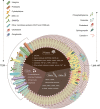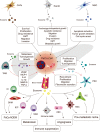The potential roles of exosomes in pancreatic cancer initiation and metastasis
- PMID: 32878635
- PMCID: PMC7466807
- DOI: 10.1186/s12943-020-01255-w
The potential roles of exosomes in pancreatic cancer initiation and metastasis
Abstract
Pancreatic cancer (PaCa) is an insidious and highly metastatic malignancy, with a 5-year survival rate of less than 5%. So far, the pathogenesis and progression mechanisms of PaCa have been poorly characterized. Exosomes correspond to a class of extracellular nanovesicles, produced by a broad range of human somatic and cancerous cells. These particular nanovesicles are mainly composed by proteins, genetic substances and lipids, which mediate signal transduction and material transport. A large number of studies have indicated that exosomes may play decisive roles in the occurrence and metastatic progression of PaCa. This article summarizes the specific functions of exosomes and their underlying molecular mechanisms in mediating the initiation and metastatic capability of PaCa.
Keywords: Exosome; Metastasis; Pancreatic cancer; Tumor biomarker; Tumorigenesis.
Conflict of interest statement
The authors declare no competing interests.
Figures



Similar articles
-
Potential diagnostic and therapeutic roles of exosomes in pancreatic cancer.Biochim Biophys Acta Rev Cancer. 2020 Dec;1874(2):188414. doi: 10.1016/j.bbcan.2020.188414. Epub 2020 Aug 29. Biochim Biophys Acta Rev Cancer. 2020. PMID: 32866530 Review.
-
The role of pancreatic cancer-derived exosomes in cancer progress and their potential application as biomarkers.Clin Transl Oncol. 2017 Aug;19(8):921-930. doi: 10.1007/s12094-017-1625-2. Epub 2017 Feb 6. Clin Transl Oncol. 2017. PMID: 28168600 Review.
-
Combined evaluation of a panel of protein and miRNA serum-exosome biomarkers for pancreatic cancer diagnosis increases sensitivity and specificity.Int J Cancer. 2015 Jun 1;136(11):2616-27. doi: 10.1002/ijc.29324. Epub 2014 Nov 25. Int J Cancer. 2015. PMID: 25388097
-
Role of exosomal microRNA-125b-5p in conferring the metastatic phenotype among pancreatic cancer cells with different potential of metastasis.Life Sci. 2020 Aug 15;255:117857. doi: 10.1016/j.lfs.2020.117857. Epub 2020 May 27. Life Sci. 2020. PMID: 32470446
-
Exosomal long non-coding RNAs in the diagnosis and oncogenesis of pancreatic cancer.Cancer Lett. 2021 Mar 31;501:55-65. doi: 10.1016/j.canlet.2020.12.005. Epub 2020 Dec 24. Cancer Lett. 2021. PMID: 33359452 Review.
Cited by
-
Tumor-derived exosomes drive pre-metastatic niche formation in lung via modulating CCL1+ fibroblast and CCR8+ Treg cell interactions.Cancer Immunol Immunother. 2022 Nov;71(11):2717-2730. doi: 10.1007/s00262-022-03196-3. Epub 2022 Apr 15. Cancer Immunol Immunother. 2022. PMID: 35428909 Free PMC article.
-
Dissecting the multi-omics atlas of the exosomes released by human lung adenocarcinoma stem-like cells.NPJ Genom Med. 2021 Jun 14;6(1):48. doi: 10.1038/s41525-021-00217-5. NPJ Genom Med. 2021. PMID: 34127680 Free PMC article.
-
The feedback loop between miR-222-3p and ZEB1 harnesses metastasis in renal cell carcinoma.Cell Death Discov. 2025 Mar 12;11(1):97. doi: 10.1038/s41420-025-02385-0. Cell Death Discov. 2025. PMID: 40074730 Free PMC article.
-
Unveiling the complex double-edged sword role of exosomes in nasopharyngeal carcinoma.PeerJ. 2025 Jan 13;13:e18783. doi: 10.7717/peerj.18783. eCollection 2025. PeerJ. 2025. PMID: 39822977 Free PMC article. Review.
-
Molecular Docking and Intracellular Translocation of Extracellular Vesicles for Efficient Drug Delivery.Int J Mol Sci. 2022 Oct 26;23(21):12971. doi: 10.3390/ijms232112971. Int J Mol Sci. 2022. PMID: 36361760 Free PMC article. Review.
References
-
- Bisht S, Feldmann G. Novel targets in pancreatic cancer therapy - current status and ongoing translational efforts. Oncol Res Treat. 2018;41:596–602. - PubMed
-
- Deplanque G, Demartines N. Pancreatic cancer: are more chemotherapy and surgery needed? Lancet. 2017;389:985–986. - PubMed
-
- Cameron JL, He J. Two thousand consecutive pancreaticoduodenectomies. J Am Coll Surg. 2015;220:530–536. - PubMed
-
- Seton-Rogers S. Tumorigenesis: pushing pancreatic cancer to take off. Nat Rev Cancer. 2012;12:739. - PubMed
-
- Wang L, Xie D, Wei D. Pancreatic acinar-to-ductal metaplasia and pancreatic cancer. Methods Mol Biol. 2019;1882:299–308. - PubMed
Publication types
MeSH terms
Substances
LinkOut - more resources
Full Text Sources
Medical

